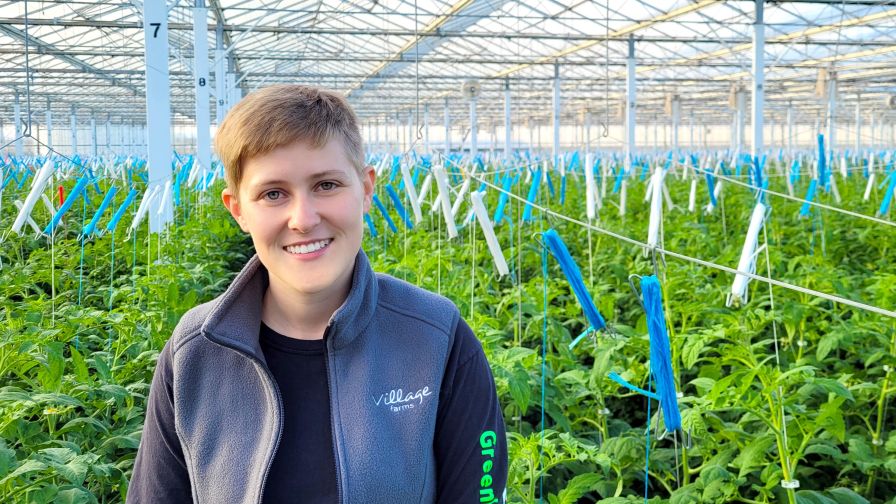Meet the Woman Who Manages Village Farms’ High-Tech Greenhouse Production
 Village Farms has been farming in the Chihuahuan Desert, just north of the U.S./Mexico border, for almost three decades. The company produces 112 million pounds of fresh produce a year, all from their greenhouses located just outside the towns of Marfa and Fort Davis. Both small towns are at an average elevation of approximately 4,700 feet above sea level, with temperatures that can range from a high of 100+°F to low of 0°F depending on the time of year.
Village Farms has been farming in the Chihuahuan Desert, just north of the U.S./Mexico border, for almost three decades. The company produces 112 million pounds of fresh produce a year, all from their greenhouses located just outside the towns of Marfa and Fort Davis. Both small towns are at an average elevation of approximately 4,700 feet above sea level, with temperatures that can range from a high of 100+°F to low of 0°F depending on the time of year.
“Extraordinary” would be a term that comes to mind, but even more so once you meet some of the growers who brave this climate and manage Village Farms’ high-tech greenhouses. Village Farms’ controlled environment agriculture (CEA) indoor farming boasts higher yields using less land and significantly fewer natural resources because they grow hydroponically and can recirculate their irrigation water time and time again. Inside the enclosed glass greenhouses, towering plants are thriving, creating a beautiful indoor garden, while outside an extremely foreboding climate awaits in the desert of Far West Texas.
One such person who manages all this beauty and precision with her expertise in CEA is Abby Lange, Facility Manager for Village Farms’ Marfa I greenhouse. Lange started with Village Farms as an intern more than eight years ago while pursuing a Bachelor of Science degree in Plant Science with a minor in Sustainable Agriculture, and a degree emphasis on Greenhouse Management from the University of Missouri-Columbia. She now manages 20 acres of tomatoes-on-the-vine (TOV) destined for local markets and the Texan grocery chain HEB, for their Texas Roots program, which the company supports.
Lange’s responsibilities include keeping the greenhouse climate and irrigation ideal for the tomato crop she oversees, prioritizing maintenance activities, keeping the packhouse running as efficiently as possible, continually updating the company’s production forecast with the most accurate information available, assisting in the training of personnel, while keeping all of the above on time and under budget.
“As an intern, I saw a broad range of jobs and work within the company, from packing to biological control to human resources, but instead of merely studying these areas of expertise and helping with basic tasks, I now coordinate them all,” Lange says. “It falls to me to ensure that communication is smooth among the greenhouse, the packhouse, maintenance, our integrated pest management (IPM) team, human resources, sales, and our safety and compliance teams, and that the work of all these teams is optimized considering the current climate, the market, our staff, and the crop.”
On a personal level, Lange’s goal is to work cross functionally to streamline the company’s crop change processes to be better able to produce more weeks out of the year, and “to never become set in my ways, as there is always more we can do to improve.”
Lange also sees automation as one of the biggest growth opportunities for Village Farms in Texas.
“Everyone is short on staff these days, so we can use automation to position our staff more effectively while making their jobs less physically intensive,” she says.
Lange thinks that data utilization is another prime opportunity.
“We have decades of climate, yield, and sales data at our disposal, and we are using it more and more, but I think we can implement more advanced analytical models to leverage all that data,” she says.
The multi-dimensional aspect of Lange’s role is a big part of her day-to-day and one of her favorite aspects of her job.
“I absolutely love telling our employees when they’re doing a great job or thanking them for what they do. Seeing the crop well cared-for, or a case of beautiful tomatoes beautifully packaged, gives me an energy like nothing else, so I make a point of reflecting that energy back to the people who make it possible to grow tomatoes in the desert day after day. I’ve heard visiting growers say that the crops and yields we achieve shouldn’t technically be possible here, so it’s something to be proud of.”
However, Lange also says her role does not come without worry, especially considering the climate in the region.
“Sometimes it’s wind, sometimes it’s hail, sometimes it’s pathogens or pests, but in any agricultural effort, there are many factors inherently outside of our control,” she says.
Lange sees a bright future for CEA growing, and Village Farms at large.
“I believe that food independence is of the utmost importance. We import myriad agricultural products because it’s cheaper than producing them here, but we never stop to look at the reasons why it’s more expensive to produce them here, or what might happen if the geopolitical or energy networks we have ever fail, preventing us from importing these things. If we want to be resilient as a nation or even as a globe, these factors need attention.”
She also says growing in the extreme climate of Texas has its benefits.
“I’ve learned more about the costs of indoor or vertical farming enough to know that it’s the free, carbon-neutral sunlight in our farming operation that is the true blessing,” she says.









